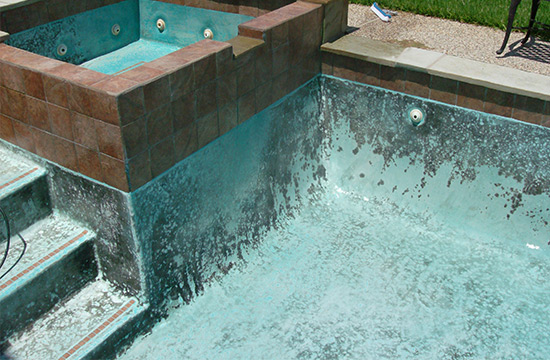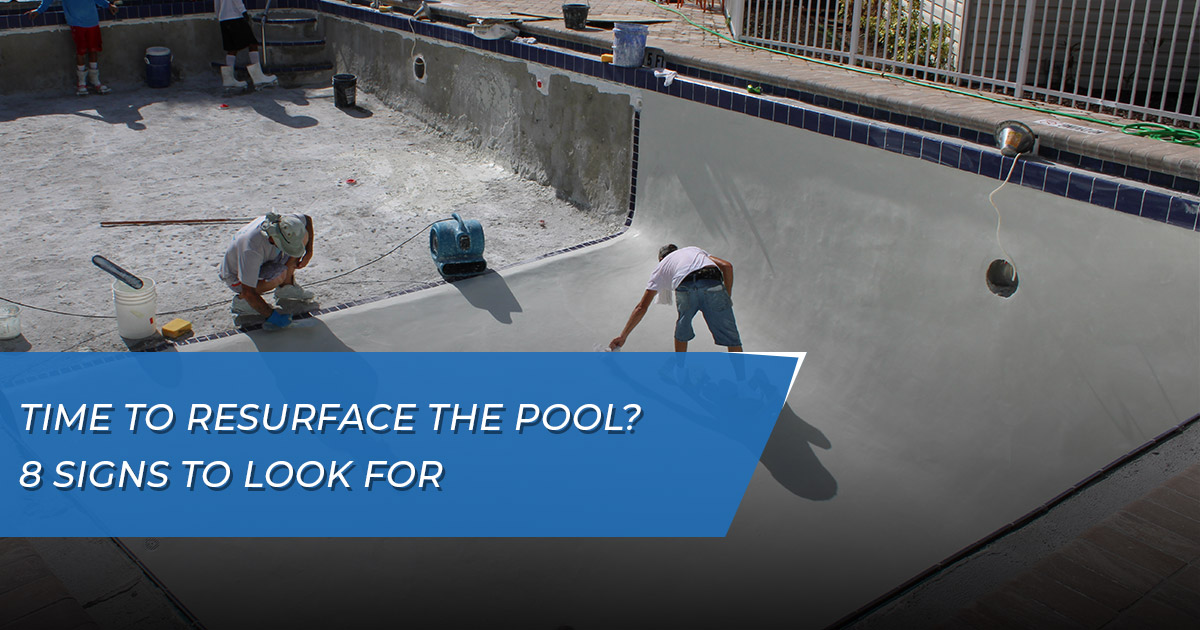Time to Resurface the Pool? 8 Signs to Look For
People tend to take a lot of pride in their swimming pools. They really bring the overall visual aesthetic of someone’s yard together, not to mention the fact that they’re a great place to host friends and family members for gatherings.
But as soon as a pool starts to look rundown (or even just begins to show its age), all of that is called into question. The pool may no longer make that excellent first impression it was once known for.
When that day comes, resurfacing the pool will likely be in order. But what is the difference between a problem that can easily be corrected on its own and a situation that calls for resurfacing the pool as soon as possible?
Related Article: Resurfacing a Pool: The Process and What to Expect
Signs You Might Need to Resurface the Pool
You can easily make this determination by watching out for a few of the bigger signs along the way.
Pay Attention to Stains
 One sign that it may be time to resurface the pool becomes evident when certain types of stains develop.
One sign that it may be time to resurface the pool becomes evident when certain types of stains develop.
Generally, even stubborn pool stains should clean or brush out in a fairly straightforward manner. You may have to use a little force, but it will be doable. However, if you are dealing with the types of stains that will not go away regardless of how hard you try, this could be a clear sign that a resurface job is in your future.
In general, stains happen when debris like leaves are not cleared from the bottom of your pool on a regular basis. Likewise, algae can cause stains if left unchecked for a long period. Skipping regular maintenance or neglecting to maintain the right balance of chemicals in the water can also lead to issues.
Regardless of the reason, stains that won’t brush out are a sign that you will need to resurface the pool sooner rather than later.
The Water Level Keeps Dropping
Typically, the water level in your pool shouldn’t change very much regularly. This is true regardless of how often it’s being used and how many people are splashing around. If your water level keeps dropping for no immediately obvious reason, it could be a sign of a far more severe problem.
The most likely cause is that you have a leak somewhere in or around your pool. If the leak is present on the side or bottom of the pool, resurfacing would certainly be a way to fix it. To determine if this is the case, use a pool leak detection kit (or even some food coloring or a similar colored liquid) in the water in the area where you think a leak may exist. The colored fluid should move toward the leak like a current.
If it doesn’t, the leak may be present in the underground plumbing that you have around your pool. In this context, you wouldn’t need to resurface the pool, but you would still have to call in a professional to help address the issue.
Related Article: Pool Leaks: Signs Types and Risks of Ignoring the Issues
Watching Out for Erosion
Another sign that you might have to resurface the pool has to do with erosion marks. Yes, these marks will indeed occur naturally in any environment where water is constantly moving against a particular surface. The more you use your pool, the more the water moves around, thus causing erosion marks on the sides.
However, you should be taking steps to help prevent this problem as part of your regular maintenance routine. That includes maintaining the right chemical balance. If you’re being proactive about taking care of your pool and are still experiencing erosion or other wear spots, it’s a sign that you might need to resurface in the not-too-distant future.
Plaster Has Begun to Flake
Along the same lines, another sign that a pool probably needs to be resurfaced involves plaster that has begun to peel in certain areas. This includes not only along the steps or floor of the pool but on the walls as well.
Unfortunately, once plaster begins to flake, there isn’t really any way to repair it without resurfacing the pool itself.
Plaster Has Begun to Lose Its Color
Similarly, if the plaster in or around your pool area has begun to show signs of discoloration, you probably need to resurface the pool. This is another phenomenon that you will likely notice at the steps of your pool first. Once the discoloration has started, it is only going to get worse until the proper resurfacing steps have been taken.
Resurface the Pool if the Walls are Cracking
Experiencing the occasional crack is not necessarily cause for concern, especially as your pool ages. You just need to fill in those cracks while they are still in their early stages to prevent them from becoming much bigger problems down the road.
Having said that, if you get a sense that you’re filling in cracks more often than you normally do, it could be an indication that you need to resurface the pool. This is true even if the crack is still just cosmetic. If it is more severe, and it has already resulted in a leak, you should resurface the pool as soon as possible. You don’t want to run into a situation where you need to fully rebuild portions of your pool to solve the problem.
You’re Starting to Lose Your Pebbles
 Always monitor any pebbles that are attached to the surfaces in your pool. This isn’t something that you have to do every day, necessarily. But if you notice any problem areas where you’re starting to lose your pebbles, definitely keep an eye on it. Pebbles become loose over time and will eventually start to dislodge, but this shouldn’t happen for 10 or even 20 years. If it begins to happen and the problem is only getting worse, you will want to resurface your pool.
Always monitor any pebbles that are attached to the surfaces in your pool. This isn’t something that you have to do every day, necessarily. But if you notice any problem areas where you’re starting to lose your pebbles, definitely keep an eye on it. Pebbles become loose over time and will eventually start to dislodge, but this shouldn’t happen for 10 or even 20 years. If it begins to happen and the problem is only getting worse, you will want to resurface your pool.
Your Fiberglass is Failing
Finally, watch out for issues with your pool’s fiberglass overlay. Warning signs that you need to resurface the pool include an overlay that has begun to delaminate as well as situations where the water is starting to become cloudy due to chalking. When you resurface, you will also probably want to choose a different type of finish to stop this from happening again.
Options to Resurface the Pool
These are just a few of the signs that you will need to resurface the pool on your property in the future. When you actually get to the process itself, you’ll want to consult a team of professionals like those at GPS Pools to help make sure everything goes as efficiently as possible.
The pool resurfacing cost that you’ll pay will vary depending on the finish you use. Three of the most popular options include PebbleTec finishes, Diamond Brite finishes and Stonescape finishes.
Marquis finishes, which are a blend of aggregated pebbles or pieces of quartz in cement that has been altered by a polymer, can last between five and 10 years with proper maintenance. Diamond pool finishes often last eight to 15 years. PebbleTec can last between 10 and 20 years.
Your resurfacing partner will help make sure you fully understand all of your choices and will also be able to perform the actual resurfacing on your behalf. After the surrounding area is properly cleared and steps are taken to protect the pool deck area, the pool will be drained and stripped. Any serious damage will be patched and repaired. After the pool’s surface has been cleaned, the existing materials will be stripped. Then, the selected finish will be applied.
We offer a wide range of pool resurfacing options to help customers get the most out of their pools. For years, we’ve worked hard to become an industry leader that people know they can trust, and we’re eager to show you just how true that is when it comes to resurfacing the pool you know and love.

